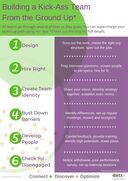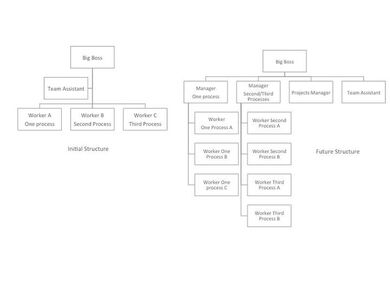Find Hidden ResourcesAre you under constraints at work and it’s taking a toll on you as the leader? Do you have more work to do but no additional headcount? Perhaps there is a hiring freeze or you’ve been told you can’t bring in replacements when someone leaves your unit.
Unfortunately, this is how a lot of big companies deal with shrinking market share or downturns in their industry. But what if I told you there might be some resources available that you can’t see yet? In fact, you may be able to recoup a full role or parts of a role, you just need to know where and how to look...
0 Comments
How Do You Build Your Team?Updated: February 2021
Most corporate team off sites (done onsite in the boardroom with food catered), are done with the intent of having a team building experience. You know what I’m talking about? One of those meeting when the team gets together away from their usual desks. A caterer brings in two Diet Cokes and three cans of Sprite for a team of 7. The food is the same each time, usually some kind of sandwiches, and the last person to select gets stuck with the egg salad. For team building you might add an exercise or two like “If you were an animal, what kind would you be and why”. With a few laughs and full tummies do you really expect your team to be more successful? Unfortunately these team building activities seldom generate success behaviours. Management may think team building happens when they invest in a few meals together, but the reality is your team just hopes for an early exit home. Seldom does the 'building' of a team really occur. Well you’ve made it to Part 4 of our series, Building a Kick-Ass Team From the Ground Up! So far we covered the foundational phases of building a kick-ass team, including the the ‘Start Up’ Phase , the ‘Building the Team Identity’ Phase and the ‘Bust Through the Barriers’ Phase. Now, your team is in ‘the flow’ and it’s time to make an important leadership shift!
As a people leader, once your team has reached this stage of maturity you’ll find yourself being needed in a different way. Let’s explore what you can do to ‘amp up’ your team’s success during what I like to call…the ‘Kum Ba Yes’ phase! Kum Ba Yes! Phase Did you ever go to summer camp, sit around the campfire and sing Kumbahyah? Maybe I’m dating myself. It symbolized the moment when a group of virtual strangers became friends as they were far away from home and surviving together. That is where the The 'Kum Ba Yes!' Phase gets its name. This phase is a time in your team’s development where people are getting along, they’re joined together, they know what their doing – they’ve become a real team! You’ll know you’ve reached this phase when you begin seeing signs that your team is operating effectively:
For the most part, you should see your people getting along, helping one another to problem solve and working towards departmental goals – productivity should be on the rise! So what should you do now that the team seems to need less of you? Well, your leadership challenge is to move from being “directive” (taking control) to “observational”. The idea here is to let up on the reins, trust and empower your team to operate with minimal intervention while guiding quietly from the sidelines. This will not only help strengthen individuals on your team, but it will also help to improve your overall team dynamic and build resiliency. Let’s take a look at some actions you can take to help strengthen your emerging Kick-Ass team during the 'Kum Ba Yes!' Phase: 1. Set Up ‘What’s Your Jam?’ Discussions – this is a good time to encourage individuals to stretch themselves to build new skills and find development toward longer-term career goals. By demonstrating an interest in their future your peeps will see you are here to support them, not just to get the work done but to help them grow. Meet with your people one-on-one to discuss their development plans. Yes, I’m talking even if you have a team of 30! Take a half hour to discuss their individual development – no not performance, their development (there is a difference). The focus should be on the individual and their career aspiration. What activities have been most interesting? What are their strengths? What are their career goals? Where do they see themselves in the future? And what steps are they currently taking? Then, determine a plan for how can you help them move forward. Don’t know what to ask at their ‘Jam Session’ - Check out this online guide. 2. Build It Up – book time quarterly with your whole team to depart from work and focus on building relationships! If you have budget, consider bringing in an external consultant to take you through a workshop on behavioural styles and communicating. If not, you can also incorporate easy and fun activities into other meetings such as when you have a project review or an all-hands update. Any activities that encourage learning about each other, working on a non-work initiative or fun experiential activities will strengthen the community of the team. 3. Feedback Gift Giving – I always say feedback is a gift, not sure who I heard that from. You can either accept it or put it on the shelf and disregard it. All of us want to receive feedback from our manager to know how we are doing, but feedback doesn’t only have to come from the boss! If you as the leader create an environment where your people feel safe and they trust each other, you can encourage open candid dialogue. This allows each team member to provide insights, reactions and suggestions to one another, which creates a culture of seeking and giving feedback – it’s a powerful tool! Recognize and support your team members when they make a point of acknowledging or provide constructive feedback. As mentioned in Part 3 Bust Through the Barriers phase I suggest carving out time at routine meetings to seek 'shout outs' to build a supportive, 'safe' work environment. Kick-Ass Team Tip - Pay Attention to Millennials In Gallup’s report, How Millennials Want to Work and Live it outlines that in today’s workplaces, our latest working generation are not getting enough feedback even when they ask for it. In fact, less than 20% feel they receive routine feedback, yet they seek it more than any other generation! So if you have Millennials in your team, pay close attention to this step! 4. Get Constructive – develop the art of constructive criticism! And it is an art! So often we shy away from criticizing anyone – when we grew up, most of us were taught ‘if you don’t have something nice to say, don’t say anything at all’. Well that probably means we didn’t receive much constructive advice! So here’s my take on it. Constructive criticism is no different than good ol’ sound advice! As the leader of a Kick-Ass team, part of developing your people means giving them candid advice, in a timely manner and particularly at this stage of team development – people do best when they are receiving regular feedback both positive and constructive - this includes you! Here are a few tips to keep in mind:
a) 'Thank you for preparing the report on demographics; it provided some good insights. I noticed you seemed frustrated when we discussed it with the client as they tried to ask questions. It is frustrating when someone cuts into your thoughts, but I think the client was trying to clarify what you were saying. Just be aware of your reaction and be prepared that clients will likely want to ask questions along the way.' b) 'Great effort on the report, I do see there are a couple of things which could be improved. The font is a bit small and it would be good to standardize the same font throughout the document.' c) 'You handled that meeting very well with the team – they were a rowdy group. Next time you may want to pause or put your hand up until they quiet down instead of talking over them.' Kick-Ass Team Tip – Help is here! If you have particularly difficult feedback to give to someone, consider talking it out with someone before you approach the person. Have them check your tone and check how it comes across. When you reach the 'Kum Ba Yes' Phase it means you’ve done a great job managing through some challenging times with your team. They are already in a good place, but they need a different kind of leader now to continue to be strong and resilient through change. During this phase, you may find you need some help in conducting team building and communication workshops, so give Dots Leadership Solutions a call to create a custom session for you. We can also help you prepare for any difficult conversations that you are putting off or provide a framework for your team’s development planning! We want to hear from you - comment below about your leadership journey in getting to Kum Ba Yes! How did you release control and move them along to full effectiveness? Watch for the next instalment on Building a Kick-Ass Team From the Ground Up – Part 5 – High Performance R Us Building A Kick-Ass Team is RewardingBuilding a kick-ass team is one of the most rewarding experiences for any leader. To see the team YOU established succeed and thrive creates a sense of pride and satisfaction like no other. Do you remember how it felt to be a part of an awesome team? You were in sync, you had fun, and you were an unstoppable machine. Everyone was connected and continuously driving in the same direction to get stuff done. This blog marks the beginning of a series of posts that will walk you through the full cycle of not only building a team, but also supercharging it! Today, we start from the beginning, which involves creating your vision, crafting roles and selecting the right members. Over the course of the next few months, I will address other topics such as the settling in period, navigating through difficult times, celebrating successes and preparing for transformative windups. The “Kick-Ass Team Building From the Ground Up” series will also include tons of practical tips and tricks for boosting your own leadership capabilities, so please follow along for full access to an abundance of insight and advice. Free Tip Sheet: Building a Kick-Ass Team From the Ground Up Without further ado, welcome to part one of our series – The Start Up Phase! There are countless reasons why you may be forming a new team right now. It may be the beginning of a new project or initiative, there may be an important new business direction underway and you have to pull a group together or you need to 'restructure' due to growth. Regardless of the reason behind the new team formation, here are your steps to get started: 1. White-Boarding Let me preface by stressing one thing – do not skip this step! Even if you’ve been handed a group of pre-selected individuals to begin with, I encourage all of my clients to start with a blank slate. Before you go sticking boxes on an org chart, ensure you are crystal clear on your own vision. Grab a whiteboard and begin considering these key questions:
Having this information readily available will assist you in figuring out which roles/functions are required on the team and what work you’ll be in charge of overall. It will also provide a basis to review the team’s progress once set up. 2. Suss Out The Work When beginning to build a team, it’s common for leaders to immediately think about managers – how many they need, who they will be etc. But there is a major drawback to this approach. What tends to happen is teams end up with too many people trying to lead without clear and distinct accountabilities – and you know what they say about too many cooks in the kitchen! Instead of beginning with management, I say do a bottom-up build! Start with considering the day-to-day work of your team and allow your structure to develop according to what actually needs to get done, not how many departments you want. In order to ensure you stack your structure with the right number and level of roles, consider these questions first to group like-functions:
Your answers to the questions above should start to create a picture of how many people you really need to DO the day-to-day work? And in contrast, how many managers are actually required to manage the people doing day-to-day work. If you can, quantify the output that will be delivered – you may have to make a few assumptions at this point – and think about the ROI (return on investment) of your resources. You tend to get bigger return with ‘doers’ than with ‘managers’. Here are some common pitfalls that many leaders face during this step of a new team formation:
3. Map Your Structure - Org Design This is when you get to move the boxes around. A good organizational design drives efficiency and success. When creating an organizational structure, I recommend an accountability-based approach – that establishes a hierarchy with clarity built-in so everyone will know who is on the hook for what. Clear accountability is a critical success factor for a smooth running team. Also vital, yet sadly overlooked, is ensuring that each Manager fully understands that their responsibility includes the development of all team members, not just direct reports. This includes formalized succession planning for managers to have replacement plans for their own roles – setting this up in the beginning will make your job a whole lot easier. Now layout a future focused org structure identifying how each role reports. Every role on the org chart needs a unique and clearly defined accountability in order to reduce confusion and improve self-sufficiency. Notice we haven’t talked about the people yet? This is done on purpose. Million Dollar Tip: Never design your structure around your people. Big mistake! (Send me a message if you want to know why) Here is an example of how you might divide work initially in order to support your longer-term structure to ramp up staffing over time: Org Design ExampleOrg structures do naturally evolve as changes are introduced over time. By developing a future plan from the outset with a ‘target’ operating model (future structure) you have a tool to not only aid in the hiring/selection process, but assess potential talent to grow and develop into expanded roles. 4. Spec Your Jobs I know this may seem tedious, but believe me, this is worth the investment! Not only will this step get you thinking about what work is needed to be done and the talent you will need, but also the document you create will serve multiple purposes over the life cycle of the team (e.g. sourcing new hires, evaluating compensation, performance management). Each role needs its own job spec - a profile. Here is a free template you can use, with a filled in example of a completed one for you to reference. Consider all the elements - similar to a job posting you would need - which details the skills necessary, the type of characteristics required to be successful and the education or knowledge which is a must or nice to have in each job. If you’ve never done this before, you can cheat by ‘Googling’ similar jobs and reviewing postings for relevant content. They will give you a clue for the type of jobs in the market (no one I know ever got into trouble for using another job posting for inspiration). Just ensure your job spec thoroughly outlines the work duties, tasks, and responsibilities so that a potential employee has an idea of what they’ll be signing up for! 5. Pick Your Talent Finally, it’s time to talk about people. I could write a whole blog on just this step – I love selecting talent – but I’ll save that for another time! I’ll keep this section brief. If you already have a pool of people to select from, resist the temptation to simply slot in people you know in the boxes. Do yourself a favour and review them against the job spec for ‘fit’, and ask yourself if they are the right people to do the job. If not, you may need to post the role. This is the step where it really pays to have objective help in screening candidates and conducting interviews. Having someone to whittle the list of candidates down to a choice few will save you time – they can also be your point person to field follow up calls and emails. I highly recommend involving several people you trust in the interview stage to help you screen for ‘fit’. It’s important that anyone new joining the team or business matches both the style and organizational culture of the company. If you have management roles, start filling those first and perhaps have them join you in future interviews as you build out the team. Prepare a series of questions that will help you probe and qualify the candidates until you find the right people to fill your roles. I recommend considering the use of a comprehensive assessment tool that can give yet another dimension about fit to the team and clues for how best to manage and communicate moving forward. Dots Leadership Solutions can assist you with crafting your structure, developing job specs, preparing your selection strategy and even screening, assessing and interviewing candidates – it’s kind of our ‘thing’. Reach out today and let’s chat about the next team you’re building. Summary: Team Start Up PhaseConclusion of the Start Up Phase:
'Building a Kick-Ass Team from the ground up' series Part 2 – Team Identity |
Most Popular Posts:
AuthorElaine Adamson is a leadership consultant with Dots Leadership Solutions Inc. A natural dot connector. Passionate about coaching team effectiveness and leadership development she shares over 25+ years of real-life tips and tricks that really work! 
Elaine believes you can discover and leverage strengths to forge a strong team dynamic despite business challenges or organizational change.
She posts some great articles on Linked In too! Topics of Interest
All
Archives By Date
November 2022
|
Specialties |
Company |
|







 RSS Feed
RSS Feed